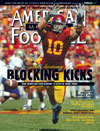AMERICAN FOOTBALL MONTHLY THE #1 RESOURCE FOR FOOTBALL COACHES
Article CategoriesAFM Magazine
|
Special Teams Game Plan Design© More from this issueIn no other phase of the game can field position be changed so dramatically in just one play as in the kicking game; yet, coaches often minimize weekly preparation in the kicking game just to get a few more offensive or defensive reps. Also, in no other phase of the game can one play be so emotionally uplifting, or, conversely, so demoralizing as in the kicking game. Additionally, consider that nearly one-third of the game is consumed by some phase of the kicking game and that for every additional 10 yards gained on a kickoff or punt return, one less first down must be earned by the offensive unit. On the other hand, successful containment of the opponent’s kick return game places an additional burden on its offensive unit in that their offensive eleven must earn additional first downs to get into scoring position. ....The full article can only be seen by subscribers. Subscribe today!
|
|
|||||||
| HOME |
MAGAZINE |
SUBSCRIBE | ONLINE COLUMNISTS | COACHING VIDEOS |
Copyright 2025, AmericanFootballMonthly.com
All Rights Reserved





